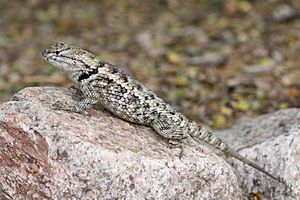Desert spiny lizard facts for kids
Quick facts for kids Desert spiny lizard |
|
|---|---|
 |
|
| Scientific classification |
The desert spiny lizard (Sceloporus magister) is a type of lizard that lives in the Chihuahuan Desert and Sonoran Desert areas of North America. It belongs to the Phrynosomatidae family of lizards.
Contents
Where Do Desert Spiny Lizards Live?
These lizards can be found in several parts of the United States. This includes Arizona, California, Texas, New Mexico, Nevada, and Utah. They also live in Mexico, in the states of Sonora, Baja California, Chihuahua, Coahuila, and Durango.
They live in desert areas from sea level up to about 5,000 feet high.
What Do Desert Spiny Lizards Look Like?
Adult male desert spiny lizards are quite colorful. They often have bright blue or violet patches on their bellies and throats. Their tails and sides can be green or blue.
Female lizards and young ones look a bit different. They have large dark spots on their backs and bellies. They do not have the bright blue, violet, or green colors that the males have.
Both male and female lizards have brownish-yellow triangle-shaped spots on their shoulders.
Size and Color Changes
A full-grown desert spiny lizard can be up to 5.6 inches long. These lizards are amazing at changing their color! In winter, they turn darker to soak up more heat from the sun. In summer, they become lighter to reflect the sun's strong rays. This helps them stay at the right temperature.
You might also see them doing "push-ups." They push their bodies up and down. This is how they show other lizards that an area is their territory.
Cool Habits of Desert Spiny Lizards
Like many desert animals, these lizards are smart about staying cool or warm. They change their body color to help control their temperature. Darker colors help them absorb heat, and lighter colors help them reflect it.
They also use camouflage to blend in with their surroundings. This makes it harder for predators to spot them.
Daily Life and Sleep
In the mornings, you can often see them basking in the sun. They like to sit on rocks or other hard surfaces that get direct sunlight. When the day gets too hot, especially in summer, they find shelter. They usually go underground into burrows or hide under rocks or wood. These shady spots are much cooler than the ground surface.
When it gets cold in late fall and winter, the desert spiny lizard hibernates. This means they go into a deep sleep until spring arrives.
Where Do Desert Spiny Lizards Hang Out?
These lizards live in many different desert areas. This includes places like the Sonoran Desertscrub, Great Basin Desertscrub, and Semidesert Grassland. They also live in chaparral and woodland areas.
You can often find them on lower slopes, plains, and in low valleys. They love to climb in tree branches. They also like to be near ground cover like piles of wood, stacks of rocks, or even packrat nests.
What Do Desert Spiny Lizards Eat?
The desert spiny lizard has a varied diet. They enjoy eating many kinds of insects. This includes ants, beetles, and caterpillars. They also munch on spiders, centipedes, and even small lizards.
How Do Desert Spiny Lizards Have Babies?
You can often spot male and female desert spiny lizards together. They mate in the spring and summer. Females lay one or two groups of eggs during these seasons.
A female lizard can lay anywhere from 2 to 12 eggs at a time. The baby lizards, called hatchlings, can start to appear as early as late May. However, they usually begin to emerge in July.
Images for kids


